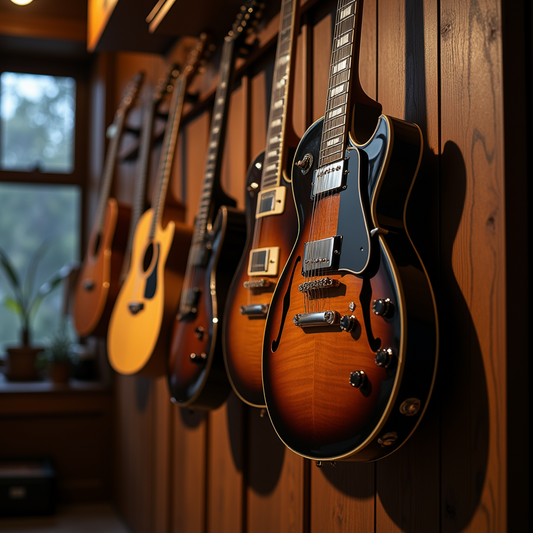How to Improve Finger Speed on the Guitar
Share
Introduction
Guitar playing is truly an art form that seamlessly weaves together rhythm, melody, and technique. Among these elements, finger speed on the guitar stands as a vital component. Whether you're a novice guitarist with dreams of playing those rapid riffs or an advanced player striving for even greater levels of virtuosity, enhancing your finger speed can catapult your guitar - playing skills to astonishing new heights. In this blog post, we will embark on a detailed exploration of a variety of methods and exercises designed to boost your finger speed on the guitar.
The Importance of Finger Speed
1. Clarity and Precision in Complex Passages
-
Finger speed is far more than a mere display of rapid playing. It serves as the key to executing complex musical passages with utmost clarity and precision. Take, for instance, the genre of shred metal. In this high - energy style, guitarists like Yngwie Malmsteen are renowned for their blisteringly fast finger movements. Their fingers dance across the fretboard, and every note is distinct, creating a wall of sound that is both intense and precise. In flamenco as well, the rapid fingerpicking is essential to convey the passionate and intricate nature of the music. The fast - paced strumming and plucking of the strings bring to life the soul of the flamenco tradition, with each note contributing to the overall tapestry of sound.
-
According to music experts, the ability to play complex passages clearly at high speeds is a mark of a highly skilled guitarist. It requires not only physical dexterity but also a deep understanding of the music's structure and rhythm. For example, in a complex jazz solo, the guitarist must be able to navigate through a series of chord changes and melodic lines with speed and accuracy. This is where finger speed becomes crucial, as it allows the player to express the nuances of the music without any hesitation or muddled notes.
2. Adding Flexibility and Ornamentation
-
Finger speed bestows upon the guitarist a greater degree of flexibility in their playing. It enables the addition of more ornamentation, such as rapid runs and trills, to melodies. Consider the works of classical guitarists like Andrés Segovia. His playing was often characterized by delicate trills and fast runs that added a touch of elegance and complexity to his interpretations of classical pieces. These ornamentations not only enhance the aesthetic appeal of the music but also showcase the guitarist's technical prowess.
-
In the realm of rock music, guitarists like Eddie Van Halen were masters of using finger speed to create unique and engaging melodies. His signature "tapping" technique, which involved using both hands to produce rapid sequences of notes, was a testament to the creative possibilities that finger speed offers. By being able to play fast, a guitarist can transform a simple melody into a flurry of notes that captivate the listener's ear.
3. Boosting Confidence
-
Improving finger speed can significantly boost a guitarist's confidence. When a player is able to effortlessly play fast passages that once seemed insurmountable, it instills a sense of accomplishment. For example, a beginner guitarist who has been struggling to play a particular fast - paced riff may initially feel discouraged. However, through dedicated practice and an improvement in finger speed, they are finally able to play it smoothly. This newfound ability gives them the confidence to take on more challenging pieces.
-
There are countless stories of guitarists who, after achieving a breakthrough in finger speed, went on to explore more complex musical territories. One such story is that of a self - taught guitarist who, after months of focused practice on finger speed exercises, was able to perform a difficult piece by Steve Vai. This accomplishment not only made him more confident in his playing but also inspired him to continue pushing his boundaries and exploring new styles of music.
Exercises for Improving Finger Speed
1. Chromatic Exercises
-
Chromatic scales are an excellent starting point for enhancing finger speed. Begin on the lowest fret of a string and play each note consecutively while moving up the fretboard. For example, on the low E string, you would play 1 - 2 - 3 - 4 - 5 - 6 - 7 - 8 - 9 - 10 - 11 - 12. This simple yet effective exercise helps to train your fingers to move quickly and smoothly across the fretboard.
-
When it comes to picking, using alternate picking (down - up - down - up) is crucial for achieving a smooth and even sound. As you become more at ease with this exercise, gradually increase the speed. A metronome is an invaluable tool in this process. Start at a slow tempo, perhaps 60 beats per minute (bpm), and incrementally raise the tempo by 5 - 10 bpm each time you practice until you reach a challenging speed.
-
Let's consider a real - life example of a guitarist who used chromatic exercises to improve their finger speed. John, a budding guitarist, was initially struggling with playing fast passages. He dedicated 30 minutes each day to chromatic exercises, starting at a slow tempo and using a metronome. Over the course of a few months, he noticed a significant improvement in his finger speed. He was able to play riffs that he previously thought were out of his reach.
-
Another variation of the chromatic exercise involves playing it across different strings. For instance, start on the low E string, play a few notes, then transition to the A string, and continue. This variation not only aids in improving finger speed but also enhances finger coordination between strings. It requires your fingers to adjust quickly to the different string tensions and fret spacings, which is a valuable skill for any guitarist.
2. Scale Exercises
-
Major and minor scales are the building blocks of guitar playing. Practicing scales at an increasing speed is a fundamental exercise for improving finger speed. Let's start with the C major scale. At first, play it slowly, with a focus on accurate finger placement and seamless transitions between notes. This slow and methodical practice helps to build muscle memory, which is essential for faster playing.
-
As you progress, experiment with different picking patterns. Strict alternate picking is a common approach, but economy picking can also be highly effective for certain scale runs. Economy picking combines alternate picking and sweep picking techniques to minimize pick movement. For example, in a fast - paced rock solo, using economy picking can allow you to play a series of notes more quickly and with less effort.
-
Additionally, practicing scales in different positions on the fretboard is beneficial. This not only improves finger speed but also deepens your understanding of the fretboard layout. Consider the case of a jazz guitarist who needs to be able to play scales in various positions to improvise effectively. By practicing scales in different positions, they can seamlessly move around the fretboard, creating smooth and flowing solos.
3. String Skipping Exercises
-
String skipping is a challenging yet highly effective method for enhancing finger speed. Start with simple patterns, such as playing a note on the low E string and then skipping to the G string to play another note. You can either create your own patterns or utilize pre - designed exercises.
-
For example, play a note on the 5th fret of the low E string, then skip to the 3rd fret of the G string, and then return to the 7th fret of the low E string, and so on. Using a metronome to control the tempo is essential. Begin at a slow tempo and gradually increase the speed as you gain more proficiency.
-
String skipping also plays a crucial role in improving accuracy. Since it demands precise finger placement on different strings, it hones your overall playing precision. A study conducted among guitarists showed that those who regularly practiced string skipping exercises had a higher level of accuracy in their playing compared to those who did not. This is because string skipping forces the guitarist to be more conscious of their finger movements and the target notes on each string.
4. Hammer - Ons and Pull - Offs
-
Hammer - ons and pull - offs are techniques that can substantially increase your playing speed without relying solely on picking. A hammer - on occurs when you play a note by striking the string with a finger and then "hammer" another finger onto the same string on a higher fret to produce a new note. For instance, play a note on the 3rd fret of the A string with your index finger and then hammer - on with your middle finger on the 5th fret.
-
Pull - offs are the opposite. Play a note on a higher fret and then "pull off" to a lower fret with a different finger. These techniques allow you to play a series of notes rapidly without having to pick each one. Consider the playing of blues guitarists, who often use hammer - ons and pull - offs to create a smooth and soulful sound.
-
When first practicing hammer - ons and pull - offs, it is essential to focus on achieving a clear and consistent sound. This may require some time and patience, as it involves developing the right amount of finger strength and control. Once you have mastered these techniques in isolation, incorporate them into scale runs and melodies to add speed and fluidity. For example, in a blues scale run, using hammer - ons and pull - offs can give the melody a more expressive and dynamic quality.
Tips for Improving Finger Speed
1. Proper Posture and Hand Position
-
Maintaining the correct posture while playing the guitar is of utmost importance for finger speed. Sit or stand up straight, with the guitar held comfortably in your lap or on a strap at the right height. This proper alignment allows for optimal blood circulation, which is essential for the muscles in your hands and arms. It also reduces the risk of strain and fatigue during long practice sessions.
-
In terms of hand position, keep your wrist straight and relaxed. Avoid excessive bending or arching of the wrist, as this can lead to discomfort and even injury over time. Your fingers should be curved in a natural shape, ready to strike the strings with precision. Think of it as a gentle claw - like shape, where each finger can move independently and efficiently.
-
Place your thumb on the back of the neck in a position that provides stability while allowing your fingers to move freely. A common error among guitarists is gripping the neck too tightly with the thumb, which restricts the movement of the fingers. A good analogy is to think of the thumb as a gentle anchor, providing just enough support without impeding the fingers' freedom.
2. Use a Metronome
-
A metronome is an indispensable tool for enhancing finger speed. It helps you develop a strong sense of rhythm and consistency in your playing. Start at a slow tempo and gradually increase the speed as you become more proficient. This methodical approach allows you to build a solid foundation of rhythm and speed.
-
When practicing with a metronome, focus on keeping each note in time with the click. If you make a mistake, don't halt immediately. Instead, keep going and strive to correct it on the next repetition. This practice builds your ability to maintain a steady tempo even in the face of challenges. For example, imagine you are playing a complex scale run with a metronome set at a relatively fast tempo. If you miss a note, don't let it disrupt your rhythm. Keep playing and make sure to get it right the next time around.
-
There are many stories of guitarists who credit the metronome with their significant improvements in finger speed. One guitarist, Sarah, was having trouble with her timing and speed. She started using a metronome religiously in her practice sessions. Over time, she noticed that not only did her finger speed increase, but her overall playing became more precise and rhythmic.
3. Take Breaks
-
While consistent practice is key to improving finger speed, taking breaks is equally crucial. Continuous practice without rest can lead to muscle fatigue, which can ultimately result in a decline in performance and even injury. Take short breaks every 20 - 30 minutes to stretch your hands and relax your muscles.
-
During breaks, you can perform simple hand stretches. For example, spread your fingers wide apart and then curl them back in, or gently rotate your wrists. These stretches help relieve tension and prepare your hands for the next round of practice. Consider the case of a professional guitarist who was on a tight rehearsal schedule. He initially ignored the importance of taking breaks and ended up with a hand injury that set him back weeks in his practice. After learning his lesson, he now takes regular breaks during his practice sessions, and his finger speed has improved steadily without any further setbacks.
4. Practice Slowly and Correctly
-
Many guitarists make the mistake of attempting to play too fast too soon. It is essential to start slowly and concentrate on playing each note correctly. This includes proper finger placement, picking technique, and rhythm. When you practice slowly, you are building muscle memory and laying a solid foundation for faster playing.
-
For instance, if you are learning a new scale, play it at a slow tempo, ensuring that each note is clear and that your fingers are moving in the correct sequence. Once you can play a passage flawlessly at a slow speed, then gradually increase the tempo. Think of it as building a house. You need to lay the bricks carefully and evenly at the beginning to ensure a sturdy structure. In the same way, by practicing slowly and correctly, you are constructing a strong base for your finger speed development.
Conclusion
Enhancing finger speed on the guitar is a journey filled with patience, dedication, and the application of the right techniques. By integrating the exercises and tips mentioned above into your regular practice routine, you can gradually boost your finger speed and elevate your guitar - playing to an entirely new level. Remember, it's not solely about how rapidly you can play but also about playing with clarity, precision, and a sense of musicality. So keep on practicing, and before long, you'll be astounded by the progress you've made.



